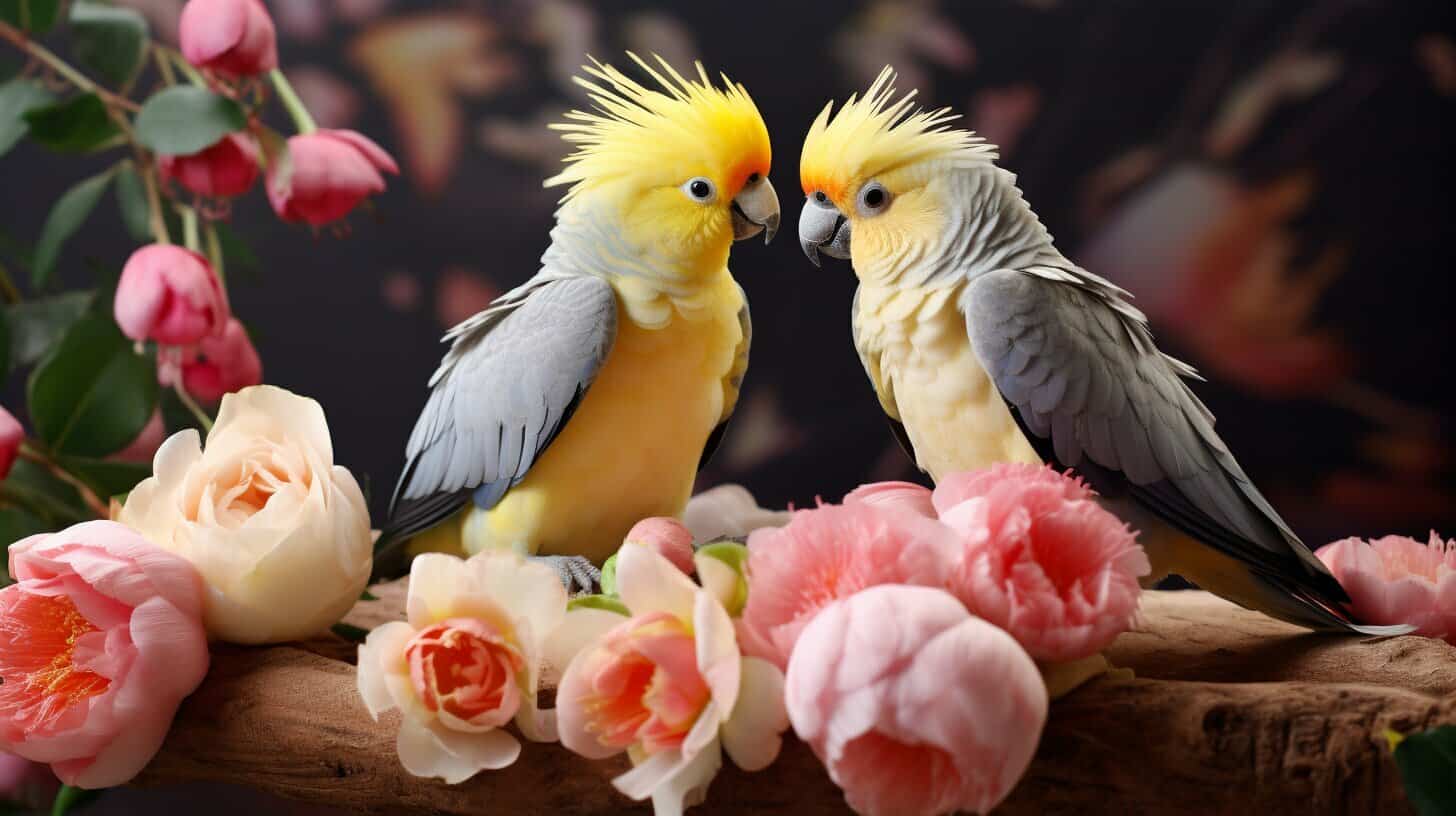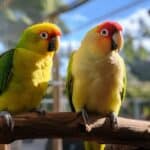Are you a bird lover considering housing kakarikis and cockatiels together? While these two species can coexist in the same aviary, it’s important to understand the compatibility factors to ensure a harmonious living arrangement.
Before making any decisions, it’s crucial to consider the potential benefits and challenges of mixing kakarikis and cockatiels. This article will provide guidelines and insights on the necessary considerations and interactions between these birds.
Key Takeaways
- Compatibility between kakarikis and cockatiels is possible, but proper care and socialisation are necessary.
- When housing kakarikis and cockatiels together, providing a comfortable and safe environment with adequate space, perches, and nest boxes is essential.
- Gradual introductions, supervised interactions, and positive reinforcement are key to fostering socialisation between the two species.
- Understanding the typical behaviour and interaction between cockatiels and kakarikis can help you identify any potential conflicts and manage them.
- Consideration of diet and health factors for both species is essential to avoid conflicts or health issues.
- While there can be many benefits to housing kakarikis and cockatiels together, such as companionship and social stimulation, specific challenges can arise, such as territorial behaviour or dominant or aggressive individuals.
Housing Kakarikis and Cockatiels Together: Considerations
When considering mixing kakarikis and cockatiels, there are important considerations to ensure the comfort and safety of both species. The size of the aviary is a crucial factor to consider, as both species require adequate space to move around and fly.
Perches of varying sizes and textures should also be provided to cater to both species. Nest boxes should be installed in various locations to ensure each species has its own designated space.
| Considerations when housing kakarikis and cockatiels together: |
|---|
| Aviary size |
| Perches of varying sizes and textures |
| Nest boxes in various locations |
It’s important to note that kakarikis are more active and boisterous than cockatiels, so ensure the aviary is large enough to accommodate their energy levels.
The layout of the aviary should also be carefully considered, ensuring enough space for each species to have its own designated area. Separating food and water stations can also help minimise conflicts between the two species.
One important consideration is the compatibility of the two species. While kakarikis are more social than cockatiels, others may display territorial behaviour. Always monitor interactions closely and separate any individuals that display aggression.
Providing a comfortable and safe environment for kakarikis and cockatiels is crucial when housing them together. Ensuring adequate space, perches, and designated areas for each species can help promote a harmonious living arrangement.
Introducing Kakarikis and Cockatiels: Socialisation Tips
Introducing kakarikis and cockatiels to each other can be delicate, requiring patience and careful observation. Here are some socialisation tips to consider:
Gradual Introductions
It’s important to gradually introduce the birds to each other in a controlled environment. Start by placing the birds in separate cages within the same room, allowing them to observe each other from a safe distance. Slowly move the cages closer until they are next to each other. Once the birds are comfortable with this setup, you can allow them to have supervised interactions outside their cages.
Supervised Interactions
It’s important to supervise their interactions closely when introducing kakarikis and cockatiels to each other outside of their cages. This can help prevent any potential conflicts or aggressive behaviour. Provide plenty of toys and perches to help distract the birds and allow them to interact on their terms.
Positive Reinforcement
Positive reinforcement can be an effective tool for encouraging socialisation between kakarikis and cockatiels. Offer treats and praise when the birds interact calmly and positively with each other. This can reinforce good behaviour and encourage a harmonious living arrangement.
These tips can help ensure a smooth socialisation process between kakarikis and cockatiels. Remember, every bird is unique, so observing its behaviour closely and making adjustments as needed is important.
Cockatiel and Kakariki Interaction: Observations
When housing kakarikis and cockatiels together, observing their behaviour and interaction is important to ensure a harmonious living arrangement.
One common observation is that kakarikis are more active and vocal than cockatiels. They may display playful behaviour, such as hanging upside down from perches and swinging around on toys. Cockatiels, on the other hand, are generally more laid back and less vocal.
Both species have distinct vocalisations, which can help determine their mood and communicate with their flock. Kakarikis have a unique chattering call, while cockatiels have a melodic whistle.
Feeding Habits
When it comes to feeding, kakarikis and cockatiels have different dietary needs. Kakarikis are primarily herbivores, while cockatiels are omnivores.
It is important to provide a balanced diet for both species and avoid potential conflicts. For example, kakarikis may try to eat the eggs laid by cockatiels, so removing the eggs as soon as possible is best.
Flock Dynamics
Kakarikis and cockatiels have different flock dynamics, which can impact their interactions when housed together.
Kakarikis are social birds and prefer to live in large flocks, while cockatiels are more solitary and territorial. Providing both species with enough space and resources is important to avoid potential conflicts.
Monitoring their interactions for any signs of aggression or dominance is also important. If any individual displays aggressive behaviour, it may be necessary to temporarily separate them from the flock and provide them with individual attention and training.
Compatibility Factors: Diet and Health Considerations
When considering housing kakarikis and cockatiels together, it is important to consider their dietary needs and potential health issues. Kakarikis and cockatiels have different requirements when it comes to nutrition, and offering a balanced diet is crucial for their well-being.
Cockatiels: These birds require a diet rich in pellets, fresh fruits and vegetables, and seeds. They should also have access to clean, fresh water at all times. Feeding them a diet high in seeds can lead to obesity and other health problems.
Kakarikis: These birds have very different dietary needs when compared to cockatiels. They are known to be primarily herbivorous, and in the wild, they feed on various seeds, fruits, vegetables, and plants. Providing them with a high-quality pellet-based diet supplemented with fresh fruits and vegetables is important.
Although they have different dietary needs, offering a varied diet that includes fresh fruits and vegetables can benefit both species. However, it is important to ensure that the diet offered is appropriate for both birds and doesn’t cause conflicts or health issues.
Regarding health considerations, kakarikis are known to be more susceptible to respiratory infections than cockatiels. Therefore, it is important to keep their living area clean to prevent the spread of disease. Additionally, if one bird becomes sick, it is important to separate them from the other birds to prevent the spread of infection.
Benefits and Challenges of Housing Kakarikis and Cockatiels Together
When considering housing kakarikis and cockatiels together, there are several potential benefits and challenges to consider.
Benefits
One major benefit of housing these species together is social stimulation. Kakarikis and cockatiels are social birds and thrive in the company of others. By living together, they can provide each other with companionship and a sense of security.
Additionally, housing both species together can provide a more diverse flock environment. This can lead to increased activity and exploration, which can help prevent boredom and other negative behaviours.
Challenges
While housing kakarikis and cockatiels together can be beneficial, it is important to be aware of potential challenges that may arise.
One challenge may be territorial behaviour. Both species can be protective of their space and may become aggressive towards their aviary mates if they feel threatened. Providing enough space and resources for each bird, such as multiple perches and feeding stations, is important to manage this.
Another challenge may be dominant or aggressive individuals. In any bird group, individuals may assert dominance over others or engage in aggressive behaviour. Monitoring the birds’ interactions and separating individuals who become overly aggressive is important.
Housing kakarikis and cockatiels together can be a rewarding experience for birds and owners, but it is important to approach it with caution and awareness of potential challenges.
Conclusion
In conclusion, while kakarikis and cockatiels can live together in the same aviary, it is important to consider the compatibility factors between these species before housing them together.
Proper care and socialisation are crucial for a harmonious living arrangement. When introducing kakarikis and cockatiels to each other, gradual introductions, supervised interactions, and positive reinforcement are key. It is also important to consider the size of the aviary, perches, nest boxes, and other important aspects that ensure a comfortable and safe environment for both species.
While housing kakarikis and cockatiels together can provide social stimulation and companionship for both species, challenges such as territorial behaviour or dominant/aggressive individuals may arise. Managing these challenges requires careful observation and strategies such as providing separate feeding stations or perches.
Overall, understanding the compatibility factors and providing proper care and socialisation are essential for successfully cohabitating kakarikis and cockatiels. If done correctly, this mix can provide a rewarding and enriching environment for both bird species.
FAQ
Q: Can kakarikis live with cockatiels?
A: Yes, kakarikis and cockatiels can live together in the same aviary. However, it is important to understand the compatibility factors between these species for a harmonious living arrangement.
Q: What are the considerations when housing kakarikis and cockatiels together?
A: When housing kakarikis and cockatiels together, it is important to consider the size of the aviary, the types of perches and nest boxes provided, and other aspects that ensure a comfortable and safe environment for both species.
Q: How should kakarikis and cockatiels be introduced to each other?
A: It is recommended to introduce kakarikis and cockatiels gradually, with supervised interactions and positive reinforcement. This helps foster socialisation between the two species.
Q: What are the typical behaviours and interactions between cockatiels and kakarikis?
A: Common observations include vocalisations, feeding habits, and flock dynamics. It is important to monitor for any potential conflicts that may arise between these species.
Q: What diet and health considerations should be considered when housing kakarikis and cockatiels together?
A: When living together, it is important to consider both kakarikis’ and cockatiels’ dietary needs and potential health issues. A qualified avian veterinarian can provide tips on addressing potential conflicts or health issues.
Q: What are the benefits and challenges of housing kakarikis and cockatiels together?
A: Housing kakarikis and cockatiels together can provide social stimulation and companionship for both species. However, challenges such as territorial behaviour or dominant/aggressive individuals may arise, and strategies to manage them should be implemented.
Further Reading
If you found this article interesting or useful, you should also read this article: Can Kakarikis Live with Other Birds?



Have comments or questions about this article? Then get involved!
Spotted an error or something we have missed? Let us know